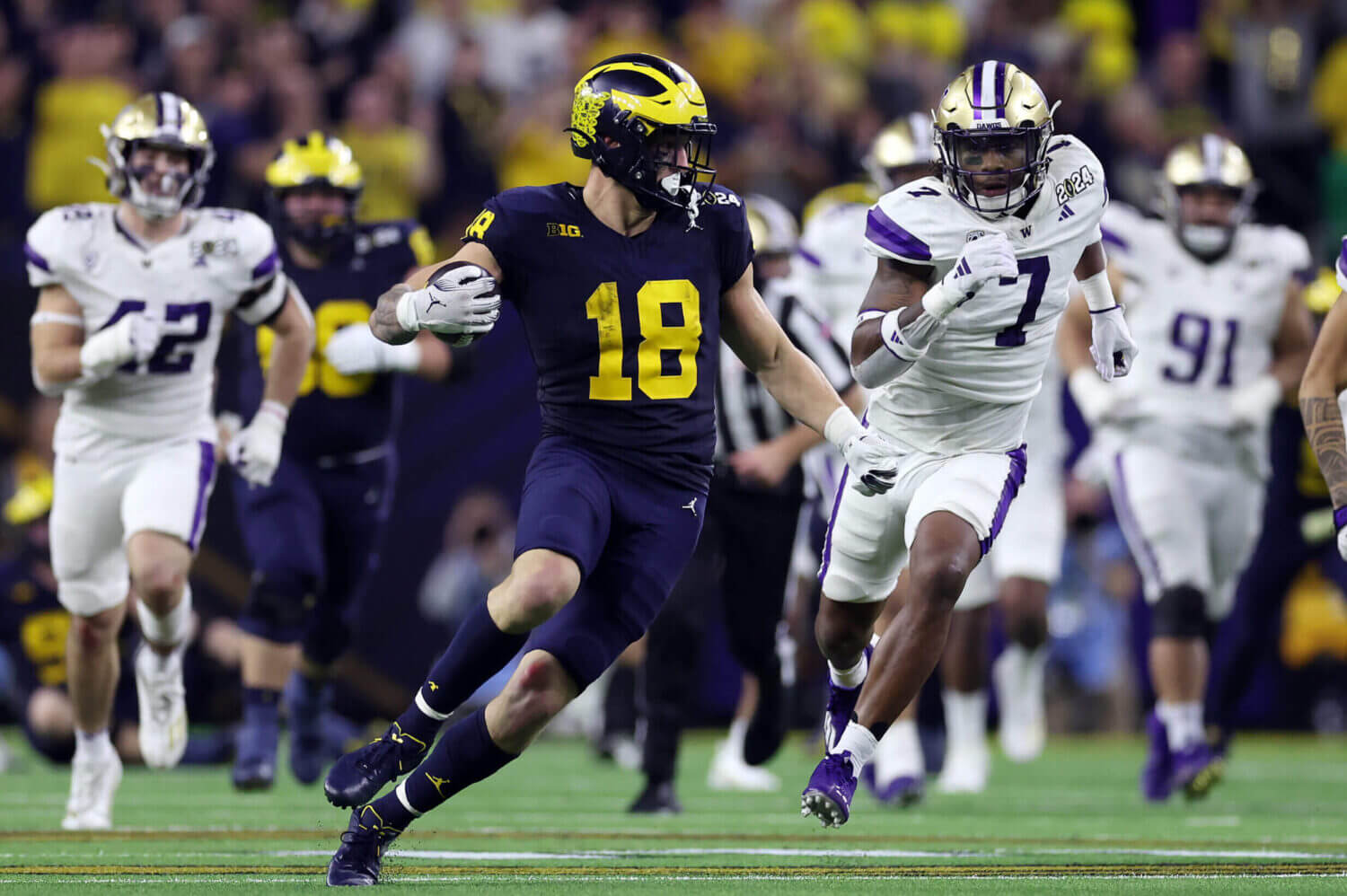Seems like a P5 pipe dream. Super league is going to be the big ten & SEC with big 12 becoming the G5
This was/is being put together without the BIG or the SEC. I like pro/rel in general, but what gets left out of the idea is that in leagues that have it, the league schedules are the same: each team plays home and away against every other team-there's no doubt as to who goes up or down. With the 80 team league there probably will always be unbalanced schedules which will lead to a mess over who should go up or down-especially given the $ involved.
Another unknown is what impact the several law suits (NIL back pay and anti-trust issues) pending against the schools, conferences and NCAA will have. Theoretically, the schools and conferences could be looking at massive judgments against them which could lead to private equity or other investors looking to get into the game. As the article mentions, FSU has already been looking into private equity as means of funding. They can't be the only ones.
Here is the article (SIAP):
Inside the college football ‘Super League,’ one powerful group’s idea to fix a ‘dead’ system
Andrew Marchand and
Stewart Mandel
One league overseeing college football’s highest level. No more conferences as we’ve known them. Playoff berths being decided solely on the field. Promotion and relegation for smaller schools. Players being paid directly. NIL and the transfer portal, managed.
A group of influential leaders wants to make all this happen soon — and they are pitching it as the best way forward for a sport they believe needs saving.
Several college presidents, Roger Goodell’s primary lieutenant at the
NFL and some of sports’ top executives have devised a plan — dubbed by outsiders as a “Super League” — to completely transform college football, those involved in the group “College Sports Tomorrow” (CST) told
The Athletic. Although the plan has drawn skepticism from within the sport’s current institutions, the people behind the ideas believe they must be implemented.
“The current model for governing and managing college athletics is dead,”
Syracuse chancellor Kent Syverud told
The Athletic during an interview.
West Virginia president Gordon Gee added, “We are in an existential crisis.”
Syverud and Gee are part of CST, a 20-person group which also includes the NFL’s No. 2 executive Brian Rolapp, Philadelphia 76ers owner David Blitzer and lead organizer Len Perna of TurnkeyZRG, the search firm that places nearly all the top conference commissioners, including recently the Big Ten’s Tony Petitti.
They are trying to implement a drastically new system that would replace the
NCAA and the College Football Playoff and potentially provide a solution for the hurricane of current and future lawsuits aimed at the business of the sport, plus the NIL and transfer portal issues that, they believe, have put college athletics as a whole in peril.
The current CST outline would create a system that would have the top 70 programs — all members of the five former major conferences, plus
Notre Dame and new ACC member
SMU — as permanent members and encompass all 130-plus FBS universities.
The perpetual members would be in seven 10-team divisions, joined by an eighth division of teams that would be promoted from the second tier.
The 50-plus second-division teams would have the opportunity to compete their way into the upper division, creating a promotion system similar to the structure in European football leagues. The 70 permanent teams would never be in danger of moving down, while the second division would have the incentive of promotion and relegation.
The playoffs would not require a selection committee, as the eight division winners and eight wild cards from the top tier would go to the postseason. The wild-card spots would be determined by record and tiebreakers, much like the NFL.
CST borrows ideas from leagues like the NFL,
Premier League and
MLS to create a system that they believe would bring more television value and sustainability. Not coincidentally, some of its most influential members have direct ties to those leagues.
Thus far, the group is struggling to gain traction with the schools that would play in their proposed “Super League.” The ACC board of directors heard a presentation from the group in February. However, planned dinners with administrators from the Big Ten, SEC and Big 12 all were called off. Spokespersons for the Big Ten and SEC said commissioners Petitti and Greg Sankey, respectively, have not met with Perna’s group.
Leagues have been hesitant and canceled meetings so as not to upset their current broadcast partners, including ESPN and Fox, according to one executive briefed on the commissioners’ thoughts.
Chief among the obstacles this new venture faces are the billions of dollars in TV deals that all the top conferences have locked in with the major networks: ESPN/ABC, Fox, NBC and CBS. The FBS conferences recently signed off on a six-year, $7.8 billion extension with ESPN for the exclusive rights to the expanded College Football Playoff.
The Big Ten’s deals run through the 2029-30 season, the Big 12’s run through 2030-31 and the SEC’s exclusive deal with ESPN runs through 2033-34. One TV executive called the idea that there is a lot more untapped money in the market “naive.” One CST executive said that the major networks with existing deals would likely need to buy into the plan before it could go to the open market in the 2030s.
Universities would own a percentage of the league, a model derived from MLS where it was devised by former president Mark Abbott, who is involved with CST. Unlike the soccer league, the revenue distribution would not be an even split among all competitors, as top brands like
Alabama and Notre Dame would receive more of the financial pie. CST believes there would be added value in negotiating TV deals as one entity and creating broadcast windows that make more sense, much like the NFL’s approach.
While the CST model would eliminate the longtime conference structure for football, it would create one entity to negotiate with a prospective union that would represent the players on NIL, transfer portal and salary structure rules. This embrace of collective bargaining could allow it to avoid the antitrust issues that have limited the NCAA’s ability to enforce its own rules.
“The only way to solve the problem is to have a solution that is legally defensible, politically acceptable, commercially prudent and is able to strike a partnership with student athletes in a way that’s really good for them,” Perna told
The Athletic.
College administrators are particularly concerned about the House v. NCAA class-action suit in Northern California, seeking NIL revenue denied to athletes prior to 2021 rule changes. If the plaintiffs are successful, the NCAA and the power conferences could be on the hook for billions in damages. The House case is one of
several potentially crippling federal antitrust suits related to athlete employment rights and NIL compensation.
“I really think conferences in the NCAA are at a very significant likelihood of going bankrupt in the near future because of the lawsuits, both the ones that are going to trial soon and those that will follow,” Syverud said.
Perna started on the project three years ago and is viewed as its figurehead. He is well-connected in college sports through his role at Turnkey.
According to two executives briefed on the proposal, one reason the FBS commissioners last month self-imposed a March 15 deadline to approve the six-year College Football Playoff extension was to stave off CST’s push. During
The Athletic’s reporting, executives involved in college football were inquiring, “What do you know about the Perna/Rolapp group?” They conveyed alarm about what could be formulated, along with doubt as to why this group would be the one to solve the complex issues facing the NCAA.
While critics in media and college sports who have heard about CST have warned of private equity’s involvement, Perna insisted this is not a money-making venture for the individuals in his group. He said CST raised initial money to pay for fees incurred but declined to say how much. The plan is for the new format to create more revenue on the premise that there is more TV money to be generated in a model comparable to the NFL’s TV setup.
“We’ve been looking at something that’s large enough that it gives everybody a chance to compete, and that does translate into about 70 schools,” Syverud said. “That also creates content that’s more valuable so that it generates the resources to do more things that the university presidents think are important for college sports. It is not the case that the money to do what’s right for our college athletes in football is just going to emerge from nowhere. Somehow it has to be generated. That’s what we are trying to figure out, as well.”
Multiple prominent college leaders in recent months have spoken bluntly about a future in which schools directly pay their players. Private equity funding could provide schools an influx of capital to address those legal matters and competitively compensate their athletes, in return for a stake in the schools’ athletics business.
One top college football administrator claimed CST is trying to “buy college football.” CST countered that it is only trying to create a system for football that in turn would result in the finances needed for non-revenue-generating sports to survive and thrive. Under the plans, the non-football sports would stay in their current conference structure.
“Athletes need to be paid and are going to be paid,” Syverud said. “Most of the rules against paying athletes, including some of those that are still in place, are likely to fall in the courts. We’re going to need to sustain women’s sports, Olympic sports and we’re going to have to have competitive equity and some methods to have a labor structure that is sensible. For all that, I think you need a more centralized national college league.”
CST is not alone in trying to find solutions. The SEC and Big Ten, the two most powerful football conferences, have formed
an advisory alliance focused on “a sustainable future of college sports,” as one clear example. At least one school, Florida State, has been actively exploring a private equity partnership of its own.
Rolapp’s involvement in CST has raised eyebrows. He was the mastermind of the NFL’s current $110 billion in TV deals and has been sought for top college commissioner jobs. While it is in the best interest of the NFL to have its feeder system of college football be strong, executives briefed on Rolapp’s role insist the league is not involved. Rolapp declined to comment.
CST leaders maintain their intentions are pure — and that they are in a hurry to get going. An avalanche of legal activity could dramatically increase the likelihood that their plan or something like it could take hold. Even prior to that day of potential foundational change, CST wants to lead from the front, not behind.
“Speed is our friend,” Gee said. “We don’t have a lot of time to waste.”

